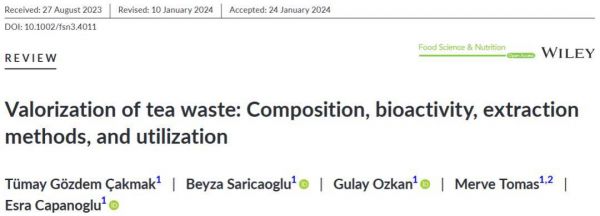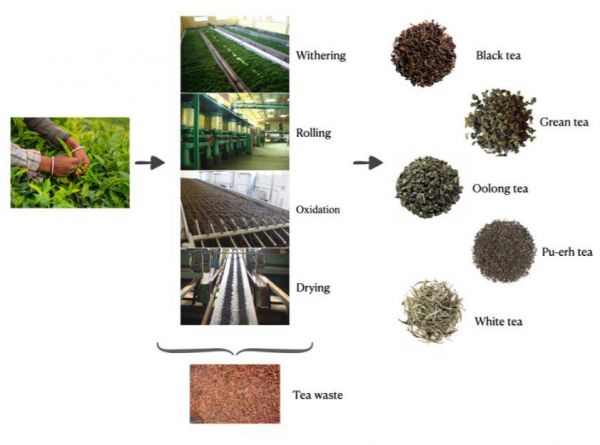
Tea is the most consumed beverage worldwide and has many health effects. Although there are many different types of tea, black tea and green tea comprise 98% of total tea production in the world. Tea waste production consists of withering, crushing, fermentation, drying and finally packaging processes. All of the waste generated during this production line is called tea waste. Tea production results in a significant amount of waste that cannot be effectively used for value creation. This waste contains many different components including protein, fiber, caffeine, and polyphenols. Due to its rich composition, it can be revalorized for different purposes. In this study, the general composition and bioactive compounds of tea waste were reviewed. Despite the fact that there have been few studies on the bioactivity of tea waste, those studies have also been discussed. The extraction techniques that are used to separate the compounds in the waste are also covered. It has been indicated that these valuable compounds, which can be separated from tea wastes by extraction methods, have the potential to be used for different purposes, such as biogas production, functional foods, food additives, silages, soluble packaging materials, and adsorbents. Although there are some studies on the revalorization of tea waste, new studies on the extraction of bioactive compounds are necessary to improve its utilization potential.

中文摘要
茶是全球消费最多的饮料,并具有许多健康效果。尽管茶的种类繁多,但黑茶和绿茶占全球茶叶总产量的98%。茶叶废弃物的产生包括萎凋、粉碎、发酵、干燥以及最终的包装过程。在这一生产线中产生的所有废弃物统称为茶叶废弃物。茶叶生产产生了大量无法有效用于价值创造的废弃物。这些废弃物包含许多不同的成分,包括蛋白质、纤维、咖啡因和多酚。由于其丰富的成分,它可以被重新增值用于不同的目的。在本研究中,回顾了茶叶废弃物的一般成分和生物活性化合物。尽管关于茶叶废弃物生物活性的研究较少,但这些研究也已被讨论。还涵盖了用于分离废弃物中化合物的提取技术。研究表明,这些可以通过提取方法从茶叶废弃物中分离出来的有价值化合物,有潜力用于不同的目的,如生物气体生产、功能性食品、食品添加剂、青贮饲料、可溶性包装材料和吸附剂。尽管已有一些关于茶叶废弃物增值利用的研究,但为了提高其利用潜力,有必要进行新的研究,以提取生物活性化合物。
(资料来源:茶与生信)
编者注:
1、文章仅代表作者个人观点,不代表本平台立场,以上图文,贵在分享,如涉及版权问题,请后台联系我们删除。
2、热忱欢迎广大茶友投稿,投稿请发至:admin@chinadarktea.com返回搜狐,查看更多
责任编辑: